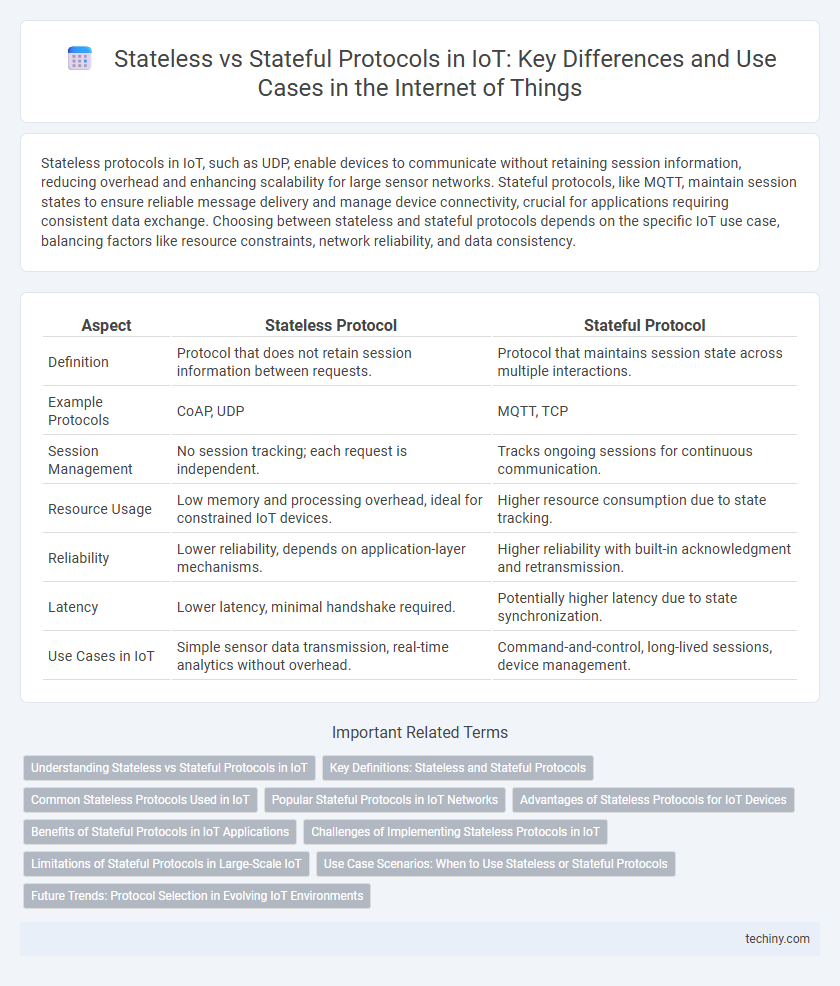Stateless protocols in IoT, such as UDP, enable devices to communicate without retaining session information, reducing overhead and enhancing scalability for large sensor networks. Stateful protocols, like MQTT, maintain session states to ensure reliable message delivery and manage device connectivity, crucial for applications requiring consistent data exchange. Choosing between stateless and stateful protocols depends on the specific IoT use case, balancing factors like resource constraints, network reliability, and data consistency.
Table of Comparison
| Aspect | Stateless Protocol | Stateful Protocol |
|---|---|---|
| Definition | Protocol that does not retain session information between requests. | Protocol that maintains session state across multiple interactions. |
| Example Protocols | CoAP, UDP | MQTT, TCP |
| Session Management | No session tracking; each request is independent. | Tracks ongoing sessions for continuous communication. |
| Resource Usage | Low memory and processing overhead, ideal for constrained IoT devices. | Higher resource consumption due to state tracking. |
| Reliability | Lower reliability, depends on application-layer mechanisms. | Higher reliability with built-in acknowledgment and retransmission. |
| Latency | Lower latency, minimal handshake required. | Potentially higher latency due to state synchronization. |
| Use Cases in IoT | Simple sensor data transmission, real-time analytics without overhead. | Command-and-control, long-lived sessions, device management. |
Understanding Stateless vs Stateful Protocols in IoT
Stateless protocols in IoT, such as UDP, do not retain session information between communications, enabling faster data transmission with reduced overhead but less reliability. Stateful protocols like TCP maintain connection states, ensuring ordered, error-checked delivery of data, critical for applications requiring guaranteed communication. Selecting between stateless and stateful protocols depends on the IoT device's need for speed, reliability, and complexity of data exchange.
Key Definitions: Stateless and Stateful Protocols
Stateless protocols in IoT manage each request independently without retaining session information, enhancing scalability and reducing server resource usage. Stateful protocols maintain connection states across interactions, enabling continuous data exchange and context-aware communication crucial for real-time IoT applications. Choosing between stateless and stateful protocols impacts device performance, network efficiency, and reliability in Internet of Things ecosystems.
Common Stateless Protocols Used in IoT
Common stateless protocols used in IoT include UDP, CoAP, and MQTT-SN, which enable efficient communication by minimizing connection overhead and reducing latency. These protocols do not maintain session information, making them ideal for resource-constrained IoT devices that require lightweight and fast data transmission. Stateless protocols enhance scalability and fault tolerance in large-scale IoT deployments by simplifying message exchanges and avoiding complex state management.
Popular Stateful Protocols in IoT Networks
Popular stateful protocols in IoT networks include MQTT, CoAP (in confirmable mode), and AMQP, which maintain session information and ensure reliable message delivery. These protocols track connection states, enabling efficient communication and quality of service in dynamic IoT environments. Their ability to manage device states and session persistence is crucial for applications requiring real-time data exchange and device coordination.
Advantages of Stateless Protocols for IoT Devices
Stateless protocols in IoT devices offer significant advantages such as reduced memory usage and simpler server design, enabling better scalability for large-scale networks. These protocols enhance device responsiveness and reliability by eliminating the need to store session information, which is critical for resource-constrained IoT environments. Additionally, stateless communication supports easier fault tolerance and quicker recovery from network interruptions, improving overall system robustness.
Benefits of Stateful Protocols in IoT Applications
Stateful protocols in IoT applications provide persistent connection management, enabling reliable device communication and efficient resource allocation. They support session continuity, which is critical for real-time data processing and secure authentication in smart environments. Enhanced fault tolerance and improved synchronization between IoT devices result in better overall system performance and user experience.
Challenges of Implementing Stateless Protocols in IoT
Implementing stateless protocols in IoT presents challenges such as limited ability to maintain session information, leading to inefficient handling of device states and increased network traffic due to repeated data transmissions. The absence of state management complicates secure authentication and authorization processes, making it difficult to enforce continuous device identity verification. Scalability issues arise as devices frequently reconnect, requiring robust mechanisms to manage data consistency and synchronization across distributed IoT networks.
Limitations of Stateful Protocols in Large-Scale IoT
Stateful protocols in large-scale IoT systems face significant limitations due to their requirement to maintain session information, which leads to increased memory and processing overhead on resource-constrained devices. This persistent state management complicates scalability and increases vulnerability to network failures, as the loss of session data can disrupt communication continuity. Consequently, stateful protocols struggle to efficiently support millions of interconnected IoT nodes with limited computational resources and dynamic network topologies.
Use Case Scenarios: When to Use Stateless or Stateful Protocols
Stateless protocols in IoT, such as UDP and CoAP, are optimized for use cases requiring low latency and minimal overhead, like sensor data transmission and simple queries in constrained networks. Stateful protocols, including MQTT and AMQP, are preferred when maintaining persistent connections and reliable message delivery is crucial, such as in device management, real-time monitoring, and control systems. Choosing between stateless and stateful protocols depends on factors like network reliability, power constraints, and the need for session management within IoT deployments.
Future Trends: Protocol Selection in Evolving IoT Environments
Future IoT environments demand protocol selection that prioritizes scalability and security, with stateless protocols offering efficient resource use by minimizing server-side storage, ideal for large-scale deployments. Stateful protocols, while requiring more memory and processing power, provide robust connection management and data consistency, essential for critical IoT applications demanding reliable real-time communication. Emerging trends emphasize hybrid models combining stateless efficiency with stateful reliability, driven by advancements in edge computing and AI-enabled network management to optimize protocol performance in dynamic IoT ecosystems.
Stateless protocol vs Stateful protocol (in IoT) Infographic

 techiny.com
techiny.com